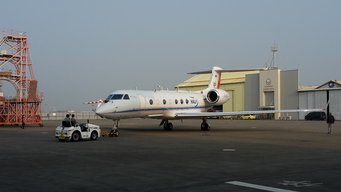HALO research aircraft measures emissions from major cities
Researchers from Mainz analyze emissions from major Asian cities to better understand and predict the extent and impact of urban air pollution on the Earth's atmosphere.
The air quality in large cities is a topical issue – especially with regard to road traffic and the health of local residents. These emissions, though, do not stay put in the conurbations. The wind can sometimes carry particles and gaseous pollutants thousands of miles in different directions. This scenario is particularly relevant in Asia, where the world's largest concentration of so-called mega-cities can be found. For a whole month up to April 9, 2018, the German Aerospace Center (DLR) with participation of researchers from the Multiphase and the Particle Chemistry Department of the Max Planck Institute for Chemistry and the Institute for Atmospheric Physics of the Johannes Gutenberg University Mainz (JGU) will be conducting research flights from Tainan in Taiwan to investigate more closely the spread and conversion of emissions from major cities such as Manila, Taipei, Seoul, Tokyo, Beijing, Shanghai and Guangzhou. The scientific leadership of the international project EMeRGe (Effect of Megacities on the Transport and Transformation of Pollutants on the Regional and Global Scales) lies with the University of Bremen.

The purpose of the mission is to better understand and predict the extent and impact of urban air pollution on the Earth's atmosphere. Previously, the scientists conducted aerial surveys of European metropolitan areas, such as London, Rome, Paris, Marseille, Barcelona, as well as in the Ruhr area and in the Po Valley (EMeRGe-EU). Since the in-flight measurement technique is dependent on cloud-free conditions in order to be able to fly at low altitudes into the cities’ emission fumes, they are taking place in the springtime when there are comparatively favorable weather conditions.
Recording the spread of regional pollution
"In particular, the conversion of gaseous pollutants into aerosol particles and their effect on cloud formation are our priority. In contrast to Europe, solar radiation, temperature and humidity are much higher in Southeast Asia, so we expect a faster conversion of aerosol precursor gases,"explains Johannes Schneider, who works as a group leader at the MPI for Chemistry and as well as an associate professor at the Institute for Atmospheric Physics of the JGU. “A total of around one hundred flight hours are planned to measure the transport and transformation of emission plumes originating from Asian mega-cities,” says the project leader, John P. Burrows of the Institute of Environmental Physics (IUP) at the University of Bremen.

The HALO research aircraft (High Altitude and Long Range Research Aircraft) is equipped with 20 different instruments to record the different primary gaseous and particulate emissions and their transport and transformation to secondary climate pollutants.
More than 50 partners
The international project EMeRGe encompasses more than 50 partners from 16 different countries. Among them are 27 from Asia. Scientists at the National Taiwan University and Academia Sinica play a special role. “These partners will carry out measurements from other airborne platforms as well as ground-based networks to complement the HALO flights,” says Burrows.
Project is funded with around six million euro
In addition to the University of Bremen, project partners in Germany are the Max Planck Institute for Chemistry, the Universities of Mainz, Heidelberg and Wuppertal, as well as the Karlsruhe Institute of Technology (KIT) and Forschungszentrum Jülich. The EMeRGe project is being funded with around six million euro by the German Research Foundation (DFG), the Max Planck Society (MPG), and DLR.
About HALO
The HALO research aircraft is a joint initiative of several German environmental and climate research institutions. HALO was started with funding from the Federal Ministry of Education and Research, the Helmholtz Association, and the Max Planck Society. The operation of HALO is supported by the DFG, the Max Planck Society, the Forschungszentrum Jülich, the Karlsruhe Institute of Technology, the GFZ German Research Center for Geosciences in Potsdam, and the Leibniz Institute for Tropospheric Research in Leipzig (TROPOS). DLR is both the owner and operator of the aircraft.

